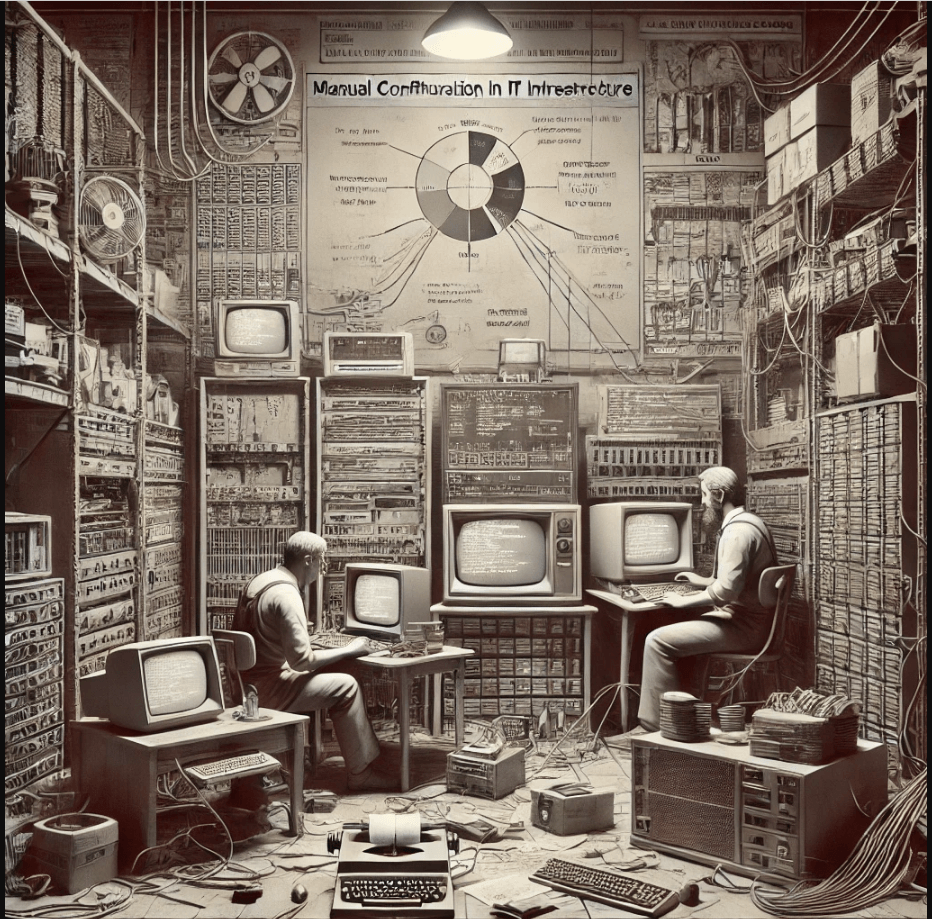
The Evolution of IT Infrastructure Provisioning and Maintenance
From Manual Setups to Autonomous Clouds
AstraOps Team
Published: March 15, 2025
In the rapidly evolving world of IT, infrastructure provisioning and maintenance have undergone a complete transformation. What began as a manual, error-prone process has evolved into an automated, streamlined, and often autonomous pipeline.
Here's a look at each major stage of this evolution, highlighting key tools that have emerged along the way.

1. The Early Days: Manual Configuration (1960s–1980s)
Overview
In the earliest days of IT infrastructure, provisioning was largely manual. Engineers would rack servers, configure them individually, and handle every aspect of network setup, storage allocation, and operating system installation. This approach required deep technical expertise and substantial time and was prone to configuration errors and inconsistencies.

Key Challenges
- Time-Consuming: Manual configuration took days or even weeks.
- Prone to Human Error: The risk of inconsistencies was high.
- Difficult to Scale: Growing the infrastructure often meant redoing the setup process from scratch.
Popular Tools
- Shell Scripts (Bash, Python): Shell scripting was the main tool for automating repetitive tasks, though it required significant customization for each environment.
2. Configuration Management: Automation Arrives (1990s–Early 2000s)
Overview
As infrastructure needs grew, the IT community began embracing configuration management to reduce repetitive tasks and enforce consistency. Configuration management tools helped automate the setup of operating systems, applications, and network configurations, making environments easier to replicate.
Key Challenges
- Learning Curve: New tools required IT staff to learn programming and scripting.
- Infrastructure as Code (IaC) Beginnings: Configuration was still manual, and infrastructure provisioning didn't fully integrate with codebases, making versioning and collaboration difficult.
Popular Tools
- Cfengine: One of the earliest configuration management tools, Cfengine automated some aspects of provisioning but had a steep learning curve.
3. Configuration Management Revolution: Standardizing Infrastructure as Code (2000s–2010s)
Overview
In the 2000s, configuration management evolved significantly with tools like Puppet, Chef, and Ansible. These tools allowed for more sophisticated and repeatable server setups, defining infrastructure through code, which laid the groundwork for today's DevOps practices.
Key Challenges
- Complexity Management: As IaC usage grew, managing codebases and dependencies became challenging.
- Shift to DevOps: IaC demanded a cultural shift, as DevOps teams had to manage both application and infrastructure code.
Popular Tools
- Puppet (2005): Brought a declarative approach to configuration, allowing IT teams to define the desired state of their infrastructure.
- Chef (2009): Chef's Ruby-based scripts made it popular among developers managing complex server environments.
- Ansible (2012): Ansible simplified configuration with YAML files, gaining popularity for its ease of use and agentless design.
4. Virtualization: Decoupling from Physical Hardware (2000s)
Overview
Virtualization allowed a single physical server to host multiple virtual machines (VMs), each with its own operating system and applications. This marked a significant leap in resource efficiency, as it allowed for better utilization of hardware and made deployment faster.

Key Challenges
- Management Complexity: Managing multiple VMs required better orchestration tools.
- Overhead: VMs used more resources than physical hardware, impacting performance.
Popular Tools
- VMware vSphere: One of the most popular solutions, providing a robust platform for managing virtual environments.
- Microsoft Hyper-V: Integrated into Windows Server, it became a popular choice in Microsoft-centric environments.
- Xen & KVM: Open-source hypervisors used in many Linux environments, providing flexibility for custom deployments.
5. Cloud Computing: The Era of On-Demand Resources (Late 2000s–Present)
Overview
Cloud computing revolutionized infrastructure by providing on-demand resources without the need to manage physical hardware. Infrastructure became a service (IaaS), and organizations could provision servers, storage, and networking with a few clicks or API calls.

Key Challenges
- Cost Management: With resources accessible on-demand, companies had to learn how to manage costs.
- Security & Compliance: Cloud providers managed the infrastructure, but customers needed to ensure compliance with regulations.
Popular Tools
- Amazon Web Services (AWS): The pioneer of IaaS, AWS provided extensive cloud services and APIs for automation
- Microsoft Azure: Azure gained traction for hybrid cloud setups and integration with Microsoft products
- Google Cloud Platform (GCP): Known for its data and machine learning services, GCP became popular for data-heavy workloads
6. Infrastructure as Code (IaC): Codifying Provisioning and Maintenance (2010s - Present)
Overview
Infrastructure as Code (IaC) emerged as a means of treating infrastructure configuration and management in the same way as application code. IaC allowed for versioning, collaboration, and repeatable infrastructure environments, making deployments consistent and reproducible.
Key Challenges
- Complexity Management: As IaC usage grew, managing codebases and dependencies became challenging.
- Shift to DevOps: IaC demanded a cultural shift, as DevOps teams had to manage both application and infrastructure code
Popular Tools
- Terraform: A leading IaC tool, Terraform enabled cloud-agnostic infrastructure provisioning, which became vital for hybrid and multi-cloud environments.
- AWS CloudFormation: Native to AWS, CloudFormation allowed teams to describe and provision AWS resources using templates.
- Pulumi: An IaC tool that supports multiple programming languages, making it more accessible to developers who prefer traditional coding over YAML or JSON.
7. Containerization and Orchestration: Decoupling Applications from Infrastructure (2013–Present)
Overview
Containers allowed applications to run consistently across different environments by bundling code and dependencies together. Orchestration tools like Kubernetes made it possible to manage thousands of containers in production environments efficiently, paving the way for microservices architectures
Key Challenges
- Complexity in Orchestration: Managing containers at scale required specialized orchestration tools.
- Networking & Storage: Handling persistent storage and networking for containers posed unique challenges.
Popular Tools
- Docker: The dominant container platform that popularized containerization across the industry.
- Kubernetes: The leading orchestration platform for managing containers, offering scalability and flexibility.
- OpenShift: Red Hat's Kubernetes-based platform for enterprise-grade container management, popular in hybrid cloud environments.
8. Serverless & Function as a Service (FaaS): A New Abstraction Layer (2015 - Present)
Overview
Serverless computing, or FaaS, allowed developers to deploy code without managing any underlying servers. This abstraction freed teams from infrastructure management entirely, letting them focus on application code while the cloud provider managed scaling, load balancing, and availability.
Key Challenges
- Debugging and Monitoring: The lack of control over the underlying infrastructure made debugging more complex.
- Vendor Lock-In: Serverless applications were often tightly coupled to a particular cloud provider.
Popular Tools
- AWS Lambda: AWS's FaaS platform, allowing teams to deploy functions in response to triggers with minimal overhead.
- Azure Functions: Microsoft's serverless platform, integrated well with Azure's ecosystem.
- Google Cloud Functions: Google's FaaS offering, often used in data and event-driven architectures.
9. Infrastructure Automation & Autonomous Clouds: The Future of IT Infrastructure (2020s - Future)
Overview
As we look to the future, infrastructure is evolving toward complete automation and autonomy. AI and ML are being integrated into infrastructure management, enabling predictive scaling, automated fault resolution, and real-time optimization.
Key Challenges
- AI Model Training and Accuracy: Effective AI-based infrastructure management requires vast data and accurate models.
- Ethics and Security: Automated infrastructure management can introduce ethical considerations, such as bias in resource allocation.
Popular Tools
- HashiCorp Nomad + Consul: Combining Nomad's orchestration with Consul's service discovery enables advanced workload scheduling and networking automation.
- AWS Systems Manager + OpsWorks: A suite of tools for automating infrastructure operations on AWS, offering solutions for patch management, compliance, and operational insights.
- AIOps Platforms (Dynatrace, DataDog, Splunk): Advanced platforms that apply AI and ML to monitoring and management, enabling automated anomaly detection, root cause analysis, and response.
The Evolution Continues
From manual setups to AI-driven autonomous clouds, IT infrastructure provisioning and maintenance have evolved from manual labor to automation and ultimately, to intelligence-driven systems. As cloud-native, serverless, and AI-powered systems become the norm, the role of IT teams continues to transform, focusing more on optimizing and innovating than on the nuts and bolts of provisioning.
This journey will likely continue as new technologies emerge, reshaping the landscape of infrastructure management. The organizations that thrive will be those that embrace these evolutions while maintaining security, efficiency, and flexibility.
Ready to evolve your IT infrastructure?
Discover how AstraOps can help you automate and optimize your infrastructure management
Schedule a Demo